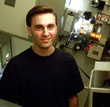|
|
 
|
|
Author
|
Topic: Big Sky P platter questions
|
|
|
John Walsh
Film God

Posts: 2490
From: Connecticut, USA, Earth, Milky Way
Registered: Oct 1999
|
 posted 03-20-2000 01:23 PM
posted 03-20-2000 01:23 PM




We demo'ed one for several months. We generally liked them. I don't know if they changed anything since we had it, so some of my following comments might not apply.They have a microprocessor inside rather than regular analog components. For example, after using it for awhile, our tech guy asked if it could be programmed to spin up the tail end after the film had ended, which they did. A handy feature. Users can't program it, only at the factory. So if you think of some feature, they might be able to do it for you in software. The drive motors are under the deck (like a Christie) to keep from pinching a loose tail end of film. The power cord goes into a socket at the bottom of the mast, and uses a detachable IEC cord- the same type as is used on computers. So you will need to find a way to keep it from being kicked out. The fuses are part of the socket (you have to get on your knees and remove the cord, then pull out a plastic holder which holds a 5mm type fuse) which sucks if you are in a hurry. The pay-out head feed arm has a paper graduated white/black to set the platter speed. That peice of paper wears against the sleeve when the pay-out head is inserted or removed. It took about 3 months for it to get damaged enough to require replacement. They have probably fixed the design by now, but I don't know how. Threading the pay-out head is a little harder because the film ("head" end) must be pushed through the rollers (unlike a Christie or current Xetrons where the film can be pushed down in from the top.) Not impossible, but a pain, if you had to thread film midway, as if the pay-out head died mid-show or film got tangled. There are no switches to set "pay-out" or "take-up." LED's tell you what mode each deck is in. I really hated the one "loose" roller for returning film at the bottom of the platter mast. It's kind of hard to explain here, but it's designed to be self-positioning, but it doesn't work too well. They may have changed that too. There is a film accumulator on the feed side, with a switch to shut down the platter if there is too much tension. Unlike some other platters (Rentec, Xetron), this switch has two contacts; one that goes to the projector automation and another that shuts down the platter itself. That way if a platter wrap puts the feed-out arm on full speed ahead, you won't get up to the booth and find a stopped projector, but a still spinning feed deck. I didn't use the make-up table to really get an idea of how it was.
| IP: Logged
|
|
|
|
|
|
|
|
|
|
|
|
|
|
|
|
|
|
All times are Central (GMT -6:00)
|
|
Powered by Infopop Corporation
UBB.classicTM
6.3.1.2
The Film-Tech Forums are designed for various members related to the cinema industry to express their opinions, viewpoints and testimonials on various products, services and events based upon speculation, personal knowledge and factual information through use, therefore all views represented here allow no liability upon the publishers of this web site and the owners of said views assume no liability for any ill will resulting from these postings. The posts made here are for educational as well as entertainment purposes and as such anyone viewing this portion of the website must accept these views as statements of the author of that opinion
and agrees to release the authors from any and all liability.
|

 Home
Home
 Products
Products
 Store
Store
 Forum
Forum
 Warehouse
Warehouse
 Contact Us
Contact Us




 Printer-friendly view of this topic
Printer-friendly view of this topic















